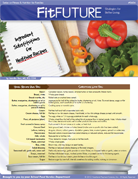Knowing when it's time to upgrade your cafeteria's POS hardware, versus sticking with what you already own, can have important implications for your foodservice operation. Upgrading too soon is certainly not good for your bottom line. But waiting too long can also be expensive.
Aaron Thein
Recent Posts
Remember the first day you started using your new POS computers? Everything was shiny and clean, your POS system ran fast (or so we hope), and your pin pads worked perfectly. Now fast forward to today. Is that still the same story?
The history of school lunch programs in America is anything but brief. The Children's Aid Society began feeding hungry, needy school children in New York City as far back as 1853. But it wasn't until the late 19th century that some major US cities, including Philadelphia and Boston, started their own school lunch programs. Over the next century, authors, war, and politics continued to shape the school lunch program into what we know it as today.
Did you know that over 82% of internet users ages 18-29 and 79% of internet users ages 30-49 are on Facebook? Even more important than this stat is the fact that many of these users are likely your district's parents. Creating a business page on Facebook to promote your school nutrition program provides a whole new way to engage with parents in a fun and rewarding way. Use it to showcase the nutritious food your staff is preparing each day, build trust with your parents, solicit valuable feedback, and more.
With over 30 million students participating in the National School Lunch Program (NSLP) everyday, you might not be surprised to hear that those same students generate over $600 million in food waste each year. Making an effort to reduce food waste can save your operation money, increase meal consumption in the lunchroom, and help minimize your school's impact on the environment.
Here are some simple solutions to reduce food waste before it happens, recover foods that are on their way to the trash, and recycle food waste that might otherwise end up in a landfill:
Coming up with new, healthy recipes for school cafeterias can be challenging to say the least. Fortunately, many states and organizations across the country have developed cookbooks full of nutritious recipes school kids will love.
Here are 13 of our favorite school cookbooks that feature plenty of locally sourced ingredients and flavors from around the globe:
Having up-to-date student information in your cafeteria point of sale (POS) system is vital to running a successful operation. Serving reimbursable meals, end of the day reporting, and reconciling deposits all depend on the quality of your student information. Understanding how to get this information out of your Student Information System (SIS) and into your POS system is an important first step.
As food costs continue to climb and many families struggle to make ends meet, school districts across the country continue to see a rise in unpaid meal charges. In SNA's State of School Nutrition 2014 survey, nearly 71% of schools reported that their meal program had unpaid student meal debt at the end of the 2012-13 school year.
For many people (including myself), talking about data protection can be a boring topic. Like buying insurance for your car or house, we don't want to think about the consequences of not having it until something goes wrong. Well, the same logic applies to your program data. Whether your district uses a Point of Sale (POS), Menu Planning or Inventory solution, making sure your data stays safe is paramount.
Trading high-calorie or high fat-ingredients for lower-calorie or lower-fat ingredients is a great way to make your favorite recipes healthier, without sacrificing flavor.
This month's FitFuture Parent Newsletter provides a list of quick and easy ingredient substitutions parents can make to just about any recipe for a guilt-free family meal.

















